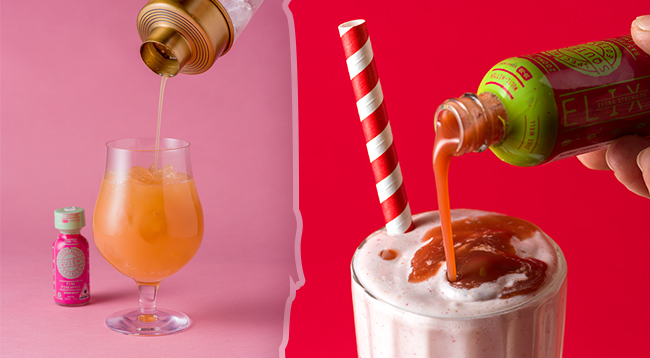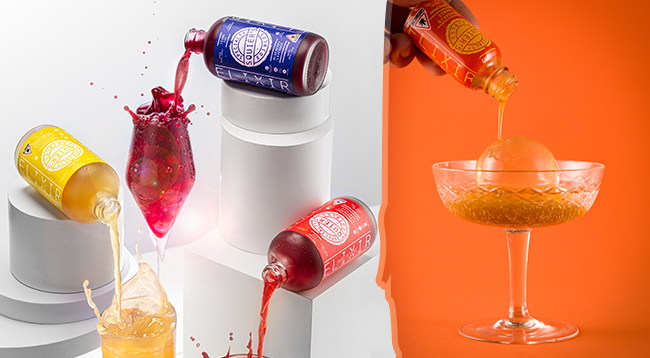For decades, consuming cannabis was a pretty straightforward recipe: roll it, light it, smoke it.
Of course, that’s not the case anymore; while flower is still king, the infused cannabis edible market in the U.S. is projected to grow at a CAGR of 17% to reach over $3 billion by 2027. That opportunity helped attract former executive chef and Maine native Zack Squier to the emerging space with Squier’s Specialty Edibles, his line of premium, 100mg THC-infused multi-serve elixirs in 2 oz. bottles, currently available at Brother Cannabis, Fire on Fore, Jar Co and other retailers in Pine Tree State. Designed as an all-purpose infusion for everything from sparkling water to ice cream, the five-SKU line embraces bold fruit flavors and local ingredients paired with premium full spectrum, solventless hash rosin. The brand also offers three varieties of ready-to-drink infused lemonades with 100mg THC per 8 oz. bottle.
With an eye towards slowly growing throughout New England, Squier’s is one of a growing cohort of players aiming to create higher standards of product quality within the nascent cannabis beverage marketplace. We spoke with Squier about the origins of the brand, the path towards drawing in new consumers, and his vision for building the “Newman’s Own of cannabis.”
As a chef interested in cannabis, what attracted you to this product format rather than others?
Honestly, we started as a savory THC-infused edible company doing hot sauces, olive oils, butters, and stuff like that; things for people to make recipes with. And one Thanksgiving, I think back in 2020 or 2021, we put out a cranberry sauce for Thanksgiving, and we decided to put out a drink recipe utilizing the cranberry sauce, just as something for people who were stuck with medicated cranberry sauce after Thanksgiving. And in the weeks after that people just started asking for more cranberry sauce. When I asked why, they said we want to make these drinks. So I thought there might be something to these drink mixers and giving people the ability to kind of dose themselves. Also I’ve been in the restaurant industry for a long time, where alcohol abuse is obviously a giant issue. I thought it’d be cool to give people an alternative to alcohol and the traditional sense of drinking.
You are based in Maine, which has a pretty developed cannabis market. What made you choose to use solventless hash in your drinks and how is that special from a culinary perspective?
The biggest thing was that we put so much passion and integrity into the ingredients, more so than anyone else. So why not just use the best possible cannabis product to pair with that – let’s take it just one step further and use solventless hash rosin. It’s more expensive, but at the end of the day, we want to give people the best possible product they can get. We’re not using food coloring or artificial flavors or natural flavors; we’re using real fruit, agave and everything’s made from scratch. Why are we putting this concentrate that’s extracted with ethanol or butane when there’s enough out there to have the best that we’re already doing for 99% of what makes up the edible?
How do your products fit in the market alongside low-dose seltzers and other cannabis RTDs?
Our 10 mg hash rosin drink mixer is only $1 more on the retail side of things than the distillate drink that’s pumped full of artificial flavors and sugar. That’s kind of our M.O. – we want to be a premium product but we’re not going to gouge people. It’s not going to be $10 more than the product sitting next to it. I don’t want to mess with trademarks, but I want to be the Newman’s Own of cannabis: a premium product made with real ingredients and integrity but we’re not going to charge you out the ass for it.
Based on your experience, what have regulators in Maine done to set infused beverage companies up for success there? Are there things that Maine has done right that could be replicable, or encouraged, in other states?
I do like how in Maine, when it comes to beverages, they allow 100 milligram beverages, which is technically still 10 servings, but at the end of the day it’s just like alcohol – people are going to have different tolerances. In Massachusetts, if I have a 30 or 40 milligram tolerance to get to where I want to be, I need to drink five seltzers to get there, or even more than that. So, I like how Maine has kind of taken the approach of setting a limit of 100 milligrams. Yes, you need to break it down by 10 milligrams and break down by dose, etc. But I kind of liked how they didn’t make the cut off at around five or 10 mgs.
Distribution has been a pain point for some cannabis edible and beverage brands. Are conditions getting better?
I think Maine is such a young market – we do all of our own self-distribution, where I believe in other states they have distribution companies. Distributing is a whole job, so I think it should eventually get to the point where it’s like the beer industry, where there are these big companies that come pick up your products and kind of take that off your plate. But it is hard to promote your product in the sense of, when it comes to social media and advertising and things like that, every state has different laws, and they’re just kind of skirting along the guidelines with everything in this industry.
Have you seen consumers who enjoy cannabis-infused beverages and food migrate to other product formats? Or are buying patterns pretty consistent?
I think a cannabis user is a cannabis user essentially, but some people might not like to smoke or just want to have something discreet, or they may be looking to quit drinking alcohol. There’s just so many different users, it’s really hard to nail down one. Personally, I don’t really smoke much flower now; I smoke a rosin pen and I use my rosin mixtures. Everyone’s different, and there’s different needs and wants depending on what people are using it for. So I don’t think it’s so black and white. That being said, cannabis drinks are new and exciting, so we’re trying to do things differently than everyone and I think we’re doing a good job. Now we need to expand and bring that to as many people as we can.

